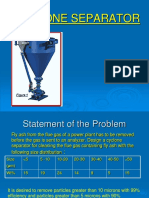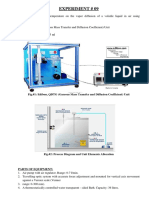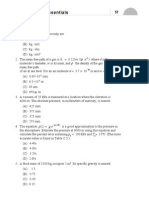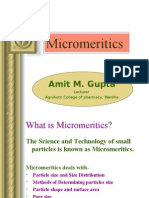EN4554/CV4554 Air Pollution Control Engineering: Tutorial 2
Uploaded by
zzz_monsterEN4554/CV4554 Air Pollution Control Engineering: Tutorial 2
Uploaded by
zzz_monsterEN4554/CV4554 Air Pollution Control Engineering
Tutorial 2
1. For the London smog problem, it was estimated that 25,000 tonnes of coal, with an
average sulfur (MW=32) content of 4%, was burned. The mixing depth (the height of the
inversion layer or cap over the city that prevented the escape of pollutants) was about
150 m, over an area of about 1200 km2. Calculate the approximate SO2 concentration
after the coal was burned. Assume the S completely converts into SO2.
2. A regularly inspection of particulate emission from stack is carried by air pollution
engineer using a heated filter and a set of cooled impingers. The stack gases are at 200
o
C and 730 mm Hg. The flow rate is determined to be 30.0 liters/minute at 20 oC and
790 mm Hg.
(a) Calculate the actual volumetric flow rate through filter (at T=200 oC and P = 730
mmHg).
(b) If 1.42 mg of particles are collected on the filter in 30 minutes, calculate the
concentration of particles in the stack gas (µg/m3).
(c) Over 15 minutes sampling time, 50 grams of water vapor are condensed and
collected in the impingers. The dry gas volumetric flow rate is measure as 30
L/min at 20 oC and 790 mm Hg. An NO2 concentration of 800 ppm is measured
downstream of flow meter. Calculate the NO2 concentration in the stack, in
which the humid gases are at T=200 oC and P=300 mm Hg. Assume all the
water is removed in impingers
3. The following data were obtained from a particulate sampling device that classifies the
particles by size. Estimate σg and d50.
Size range, µm 0-2 2-5 5-9 9-15 15-25 >25
Mass, mg 4.5 178 368 276 74 19
4 Using the question (3), to calculate the overall efficiency of a device that has the
following efficiency size relationship:
Size range, µm Dj(avenge), µm ηj, %
0-2 1 10
2-4 3 30
4-6 5 60
6-10 8 80
10-14 12 90
14-20 17 96
20-30 25 98
30-50 40 99
>50 >50 100
EN4554/CV4554 Air Pollution Control Engineering
5. A particle distribution is log-normal with a d50 of 8.0 microns, and σg of 3.0. Plot this
distribution and determine the mass percent of particles below 2.0 microns.
6. A particle distribution is log-normal with a d50 of 6.0 microns, and σg of 2.0. Plot this
distribution and determine the mass percent of particles below 2.0 microns.
7. What is the limitation of Stockes law? How to correct it?
8. Particles with a diameter of 1 mm are emitted from a tall stack. What is the relative
viscosity? Assume wind speed = 10 mil/s. ρair = 1.2 kg/m3, ρparticles = 2000 kg/m3, µ = 1.8
x10-5 kg/m.s, g = 9.81 m/s2
You might also like
- WINSEM2020-21_CHE3008_TH_VL2020210502475_CAT-2_QP___KEY_CAT-II_QP_After_Moderation_42No ratings yetWINSEM2020-21_CHE3008_TH_VL2020210502475_CAT-2_QP___KEY_CAT-II_QP_After_Moderation_422 pages
- Efecto en Las Caracteristics OrganolepticasNo ratings yetEfecto en Las Caracteristics Organolepticas4 pages
- #ASSIGNMENT VI Chem Engg Mechanical OperationsNo ratings yet#ASSIGNMENT VI Chem Engg Mechanical Operations3 pages
- Jordan University of Science and Technology Department of Civil EngineeringNo ratings yetJordan University of Science and Technology Department of Civil Engineering9 pages
- Ñoà Aùn Coâng Trình Beán Baûn Thuyeát Trình: GVHD:TH.S Leâ Nhö ThaïchNo ratings yetÑoà Aùn Coâng Trình Beán Baûn Thuyeát Trình: GVHD:TH.S Leâ Nhö Thaïch41 pages
- 2013 - REEN3001 - Catalytic Processes - December2013AlternateNo ratings yet2013 - REEN3001 - Catalytic Processes - December2013Alternate5 pages
- QUESTION 1 - Sources of Air Pollution: Answer Only Five (5) Questions All Questions Carry Equal MarkNo ratings yetQUESTION 1 - Sources of Air Pollution: Answer Only Five (5) Questions All Questions Carry Equal Mark3 pages
- KIASMA Dredging Self Sinking 09 2018 ENGNo ratings yetKIASMA Dredging Self Sinking 09 2018 ENG26 pages
- Hydraulics Laboratory: Name: Jeff Ashter B. Abragan Date: September 4, 2021No ratings yetHydraulics Laboratory: Name: Jeff Ashter B. Abragan Date: September 4, 20216 pages
- Numerical Problems On Engineering Hydrology100% (1)Numerical Problems On Engineering Hydrology11 pages
- Engineering Hydrology-Exercise and ExamplesNo ratings yetEngineering Hydrology-Exercise and Examples13 pages
- Laboratory Exercises in Astronomy: Solutions and AnswersFrom EverandLaboratory Exercises in Astronomy: Solutions and AnswersNo ratings yet
- Analytical Modeling of Solute Transport in Groundwater: Using Models to Understand the Effect of Natural Processes on Contaminant Fate and TransportFrom EverandAnalytical Modeling of Solute Transport in Groundwater: Using Models to Understand the Effect of Natural Processes on Contaminant Fate and TransportNo ratings yet
- Factors in The Proportioning of Quality Concrete Mixtures: Workability StrengthNo ratings yetFactors in The Proportioning of Quality Concrete Mixtures: Workability Strength54 pages
- Chapter 1 Numerical Interpolation and DifferentiationNo ratings yetChapter 1 Numerical Interpolation and Differentiation38 pages
- Cv4201 - Civil Engineering Management Resources Planning & ManagementNo ratings yetCv4201 - Civil Engineering Management Resources Planning & Management9 pages
- Strip Method - Alternative Load Dispersion (Discontinuity) LinesNo ratings yetStrip Method - Alternative Load Dispersion (Discontinuity) Lines1 page
- Civil Engineering Construction Technology CV4251 TUTORIAL #3, #4 and #5No ratings yetCivil Engineering Construction Technology CV4251 TUTORIAL #3, #4 and #53 pages
- CE5604-Advanced Concrete Technology: - History and Origins - Greeks: Addition ofNo ratings yetCE5604-Advanced Concrete Technology: - History and Origins - Greeks: Addition of27 pages
- Cv4201 - Civil Engineering Management Operational Research Techniques - Network AnalysisNo ratings yetCv4201 - Civil Engineering Management Operational Research Techniques - Network Analysis14 pages
- Nanyang Technological University School of Civil & Environmental EngineeringNo ratings yetNanyang Technological University School of Civil & Environmental Engineering11 pages
- CE5509 Advanced Structural Steel Design: Learning ObjectivesNo ratings yetCE5509 Advanced Structural Steel Design: Learning Objectives23 pages
- Cv4201 - Civil Engineering Management: DR Wong Wai Fan, Associate Professor, NTUNo ratings yetCv4201 - Civil Engineering Management: DR Wong Wai Fan, Associate Professor, NTU11 pages
- EN4554/CV4554 Air Pollution Control Engineering: Tutorial 1No ratings yetEN4554/CV4554 Air Pollution Control Engineering: Tutorial 11 page
- Nanyang Technological University School of Civil and Environmental EngineeringNo ratings yetNanyang Technological University School of Civil and Environmental Engineering4 pages
- CV 4201 Lecture RT1 On Financial Planning (1) - Jan 07No ratings yetCV 4201 Lecture RT1 On Financial Planning (1) - Jan 0710 pages
- Cv4201 - Civil Engineering Management Acts & Regulations Governing Professional Civil Engineering Practice in SingaporeNo ratings yetCv4201 - Civil Engineering Management Acts & Regulations Governing Professional Civil Engineering Practice in Singapore31 pages
- Flow Velocity: Measurement (Full Pipe) 1. DYE TESTING Is Done Into Two Phases, Main Line Dye Testing Examines Storm Sewers and Catch Basins Step 1No ratings yetFlow Velocity: Measurement (Full Pipe) 1. DYE TESTING Is Done Into Two Phases, Main Line Dye Testing Examines Storm Sewers and Catch Basins Step 19 pages
- Burner - Standard Requirements: Technical Development Program For Process Performance Engineers88% (8)Burner - Standard Requirements: Technical Development Program For Process Performance Engineers64 pages
- Leak Detection in Pipelines and Pipe Networks100% (1)Leak Detection in Pipelines and Pipe Networks10 pages
- Exhaust Gas Analysis of CI Engine With Co-GeneratiNo ratings yetExhaust Gas Analysis of CI Engine With Co-Generati10 pages
- ENG Brosura DeVilbiss Compact 525KS LT 2007 Rev I FINAL 020915 WebNo ratings yetENG Brosura DeVilbiss Compact 525KS LT 2007 Rev I FINAL 020915 Web2 pages
- Traffic Stream Characteristics: BY Fred L. HallNo ratings yetTraffic Stream Characteristics: BY Fred L. Hall38 pages
- General Information: 6.1 Vacuum Pump SystemsNo ratings yetGeneral Information: 6.1 Vacuum Pump Systems6 pages
- Turbo Molecular Pump: STP-A2503/A3003 Series SpecificationNo ratings yetTurbo Molecular Pump: STP-A2503/A3003 Series Specification23 pages
- HEI Performance Standard For Liquid Ring Vacuum Pumps and Compressors 4th EditionNo ratings yetHEI Performance Standard For Liquid Ring Vacuum Pumps and Compressors 4th Edition17 pages
- Drop Size Distribution Below Different Wet-Cooling Tower FillsNo ratings yetDrop Size Distribution Below Different Wet-Cooling Tower Fills9 pages
- Ajay, M., Study of Ultrasonic AtomizationNo ratings yetAjay, M., Study of Ultrasonic Atomization4 pages
- Schmidt Flow Sensor SS 30.30X: Poduct DescriptionNo ratings yetSchmidt Flow Sensor SS 30.30X: Poduct Description2 pages
- Series IEF Insertion Electromagnetic Flow Transmitter: Specifications - Installation and Operating InstructionsNo ratings yetSeries IEF Insertion Electromagnetic Flow Transmitter: Specifications - Installation and Operating Instructions28 pages











































































































